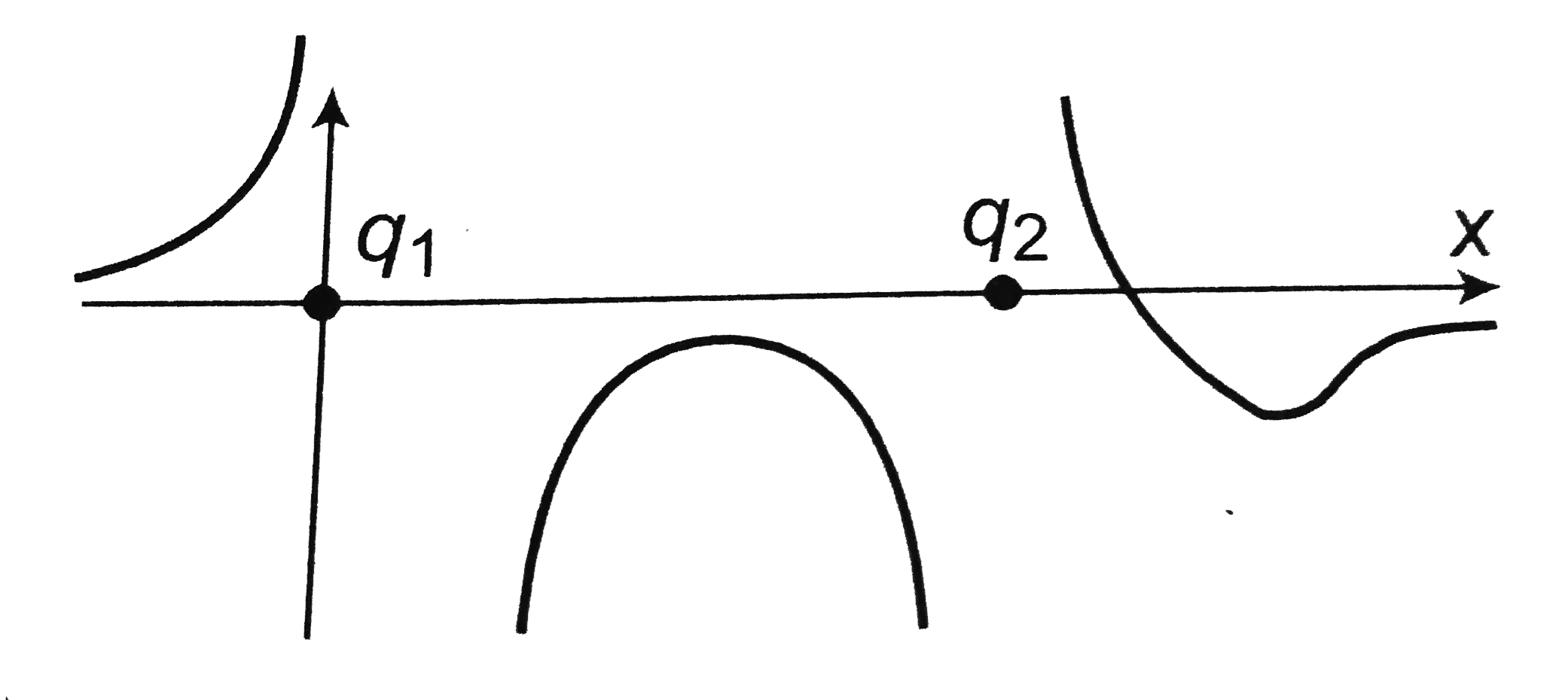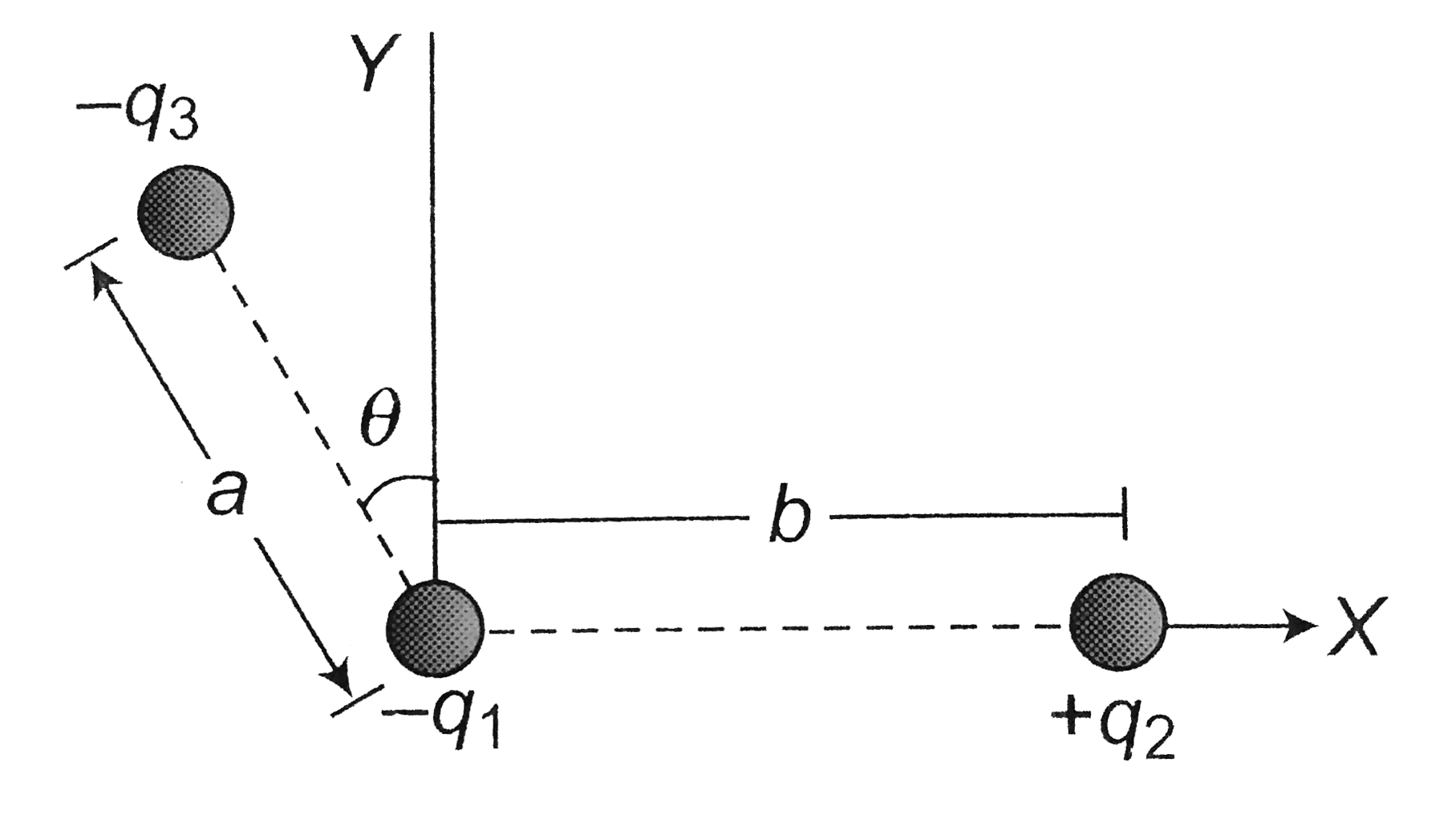In figure two positive charges q2 and q3 fixed along the y-axis ,exert a net electric force in the +x direction on a charge q1 fixed along the x-axis if a positive charge Q is added at (x,0) the force on q1

shall increase along the positive x-axis.
shall decrease along the positive x-axis.
shall point along the negative x-axis.
shall increase but the direction changes because of the intersection of Q with q2andq3.
The correct Answer is:A
Since positive charge q2andq3 exert a net force in the + X-directon on the chargte q1 fixed along the X-axis, the charge q1 is negative as shone in figure. Obviously, due to addition of positive charge Q at (x,0), the force on -q shall increase along the posiitive X-axis.

Topper's Solved these Questions
- ELECTRIC CHARGES AND FIELDSBOOK - NCERT FINGERTIPSCHAPTER - ELECTRIC CHARGES AND FIELDSEXERCISE - EXEMPLAR PROBLEMS
1 Videos
- ELECTRIC CHARGES AND FIELDSBOOK - NCERT FINGERTIPSCHAPTER - ELECTRIC CHARGES AND FIELDSEXERCISE - Assertion And Reason
15 Videos
- ELECTRIC CHARGES AND FIELDSBOOK - NCERT FINGERTIPSCHAPTER - ELECTRIC CHARGES AND FIELDSEXERCISE - Higher Order Thinking Skills
7 Videos
- DUAL NATURE OF RADIATION AND MATTER BOOK - NCERT FINGERTIPSCHAPTER - DUAL NATURE OF RADIATION AND MATTER EXERCISE - Assertion And Reason
15 Videos
- ELECTROMAGNETIC INDUCTIONBOOK - NCERT FINGERTIPSCHAPTER - ELECTROMAGNETIC INDUCTIONEXERCISE - Assertion And Reason
15 Videos
Similar Questions
A positive point charge q1 is placed at (a,0) and another positive point charge q2 is placed at (0,a) . Find the force acting on q1.
View SolutionTwo charges q1 and q2 are kept on x-axis and electric field at different points an x-axis is plotted against x. Choose correct statement about nature and magnitudes of q1 and q2

View Solution
Knowledge Check
In the figure two positive chargesq2 and q3 fixed along the Y-axis, exert a net electric force in the + x direction on a charge q1 fixed along the X-axis. If a positive charge Q is added, at {x, 0), the force on q1
 Ashall increase along the positive X-axisBshall decrease along the positive X-axisCshall point along the negative X-axisDshall increase but the direction changes because of the intersection of Q with q2and q3
Ashall increase along the positive X-axisBshall decrease along the positive X-axisCshall point along the negative X-axisDshall increase but the direction changes because of the intersection of Q with q2and q3The given figure gives electric line of force due to two charges q1 and q2. What are the signs of the two charges ?
 ABoth are negativeBBoth are positiveCq1 is positive but q2 is negativeDq1 is negative but q2 is positive
ABoth are negativeBBoth are positiveCq1 is positive but q2 is negativeDq1 is negative but q2 is positiveA positive point charge (q) is projected along (+x) axis electric field is directed along (-y) axis E=E0(−ˆj) Find trajectory of charge after x = d.
Ay=qE0dm(v0)2⋅(d2−x)By=qfE0dm(v0)2⋅(d2+x)Cy=qE0d2m(v0)2⋅(d2−x)Dy=qE0d2m(v0)2⋅(d2+x)
Two point charges(+Q) and (−2Q) are fixed on the X-axis at position a and 2a from origin respectively. At what position on the axis, the resultant electric field is zero
View SolutionTwo point charges(+Q) and (−2Q) are fixed on the X-axis at position a and 2a from origin respectively. At what position on the axis, the resultant electric field is zero
View SolutionThree charges −q1,+q2 and −q3 are placed as shown in the figure. The x-component of the force on −q1 is proportional to

View SolutionThree charges −q1,+q2 and −q3 are placed as shown in the figure. The x-component of the force on −q1 is proportional to

View SolutionThe given figure gives electric line of force due to two charges q1 and q2. What are the signs of the two charges ?

View Solution
